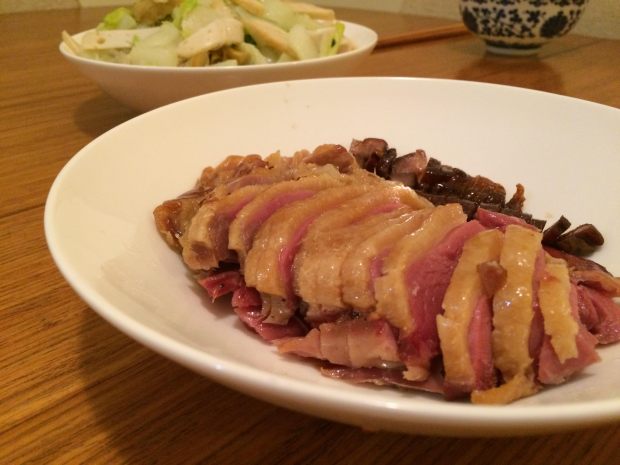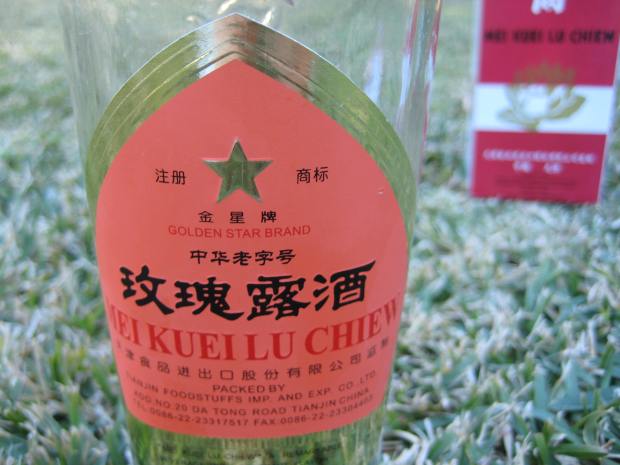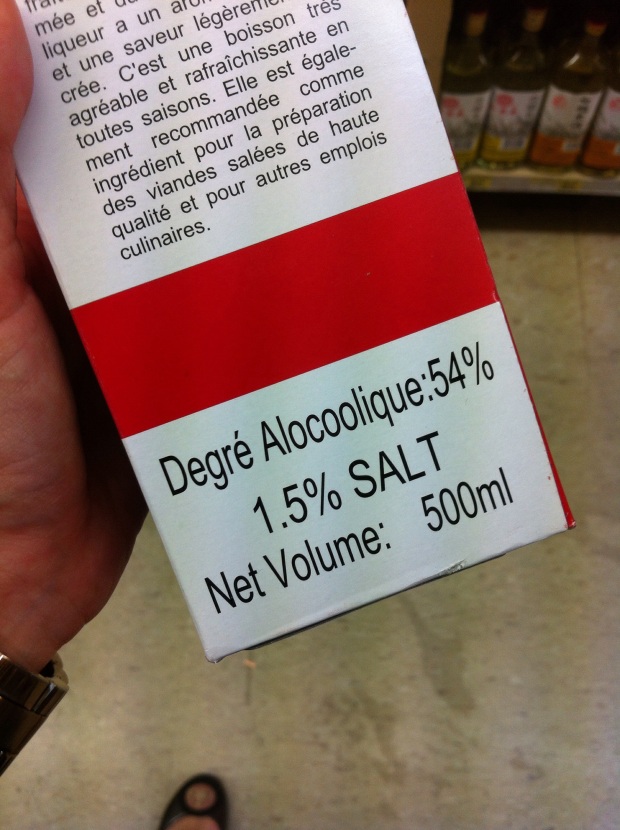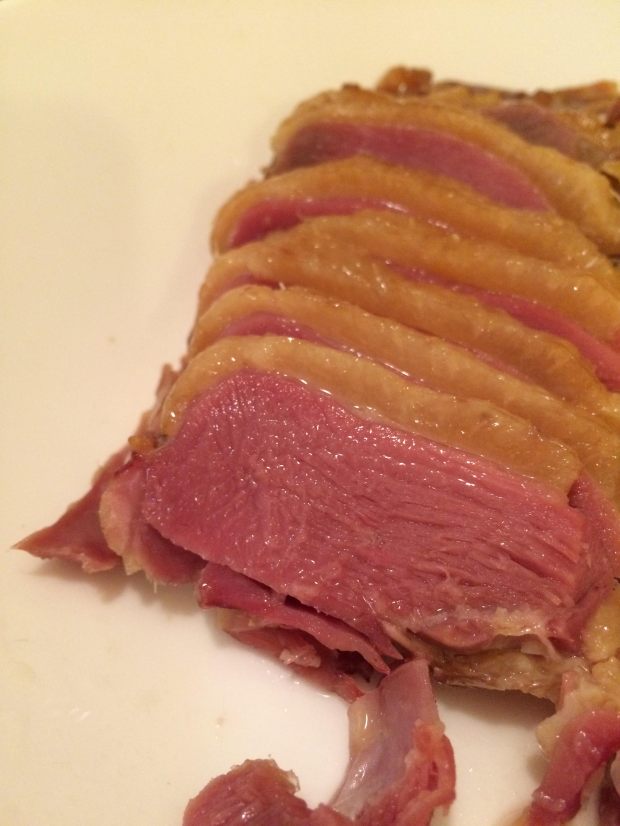Hmm, charcuterie! Apart from vegetarians, who doesn’t love a bit of cured meat? Summer conditions definitely aren’t suitable in Australia with the skin blistering heatwave that swept across the country recently. The cool, yet dry weather of a temperate winter is ideal for curing duck, Chinese style.
A traditional way to serve the duck is to steam it alongside other charcuterie like lap cheong and cured pork belly (lap yuk) over rice to make lap mei fan, a simple meal that beautifully showcases Chinese charcuterie. The fat and juices render onto the rice which makes for a delicious scented meal that is basically a heart attack on a plate.
 Deboned and sliced cured duck
Deboned and sliced cured duckI’ve talked before about Chinese rose wine (mei kuei lu chiew) and how you should spend the extra money to get the more fragrant variety. The price in Australia can vary from $1.50 a bottle to about $15. In general, avoid any rose wine that includes salt in the list of ingredients. The far cheaper, cooking variety with salt has a noticeably muted perfume. A lot of the beauty of the cured duck is derived from the rose wine so skimping out of this ingredient means you lose flavour. I’d recommend using the full 50ml of rose wine I’ve specified in the recipe below for a more aromatic result.
 If you pay $1.50 for a bottle of wine, what do you expect? This brand is acceptable. Remember to avoid the ones with salt as an ingredient.
If you pay $1.50 for a bottle of wine, what do you expect? This brand is acceptable. Remember to avoid the ones with salt as an ingredient. I searched an Asian supermarket and found the awful cheap mei kuei lu chiew just to show you! Do. Not. Buy.
I searched an Asian supermarket and found the awful cheap mei kuei lu chiew just to show you! Do. Not. Buy.Steamed and eaten with plain rice, wind cured duck is salty stuff. The best tip I can give isn’t in the making of the duck but with the cooking. It’s a little known that some restaurants prepare the duck by boiling the meat for 10 minutes before steaming. This seems incredibly counterintuitive because you’d imagine that the flavour would be vastly subdued. Instead, the duck flesh becomes tender and remains full of flavour and well seasoned. Homemade or commercial, this cooking method is the way to go.
When it comes to poultry, I’m a deboner. Partly because it can make it easier to eat and partly because I’ve never been that confident about my cleaver chopping skills. Strangely enough, deboning a chicken or duck seems to impress people, even though half the reason I do it is because of my own inadequacy. Another handy by product of deboning preserved duck is that you can use the bones to cook another dish at a later time. The bones are full of flavour and can be cooked with taro. The tuber absorbs all that flavour and residual duck fat. If a whole duck doesn’t suit, then duck maryland or duck breasts would work.
Although it’s cured so will last a few months, preserved duck is best eaten within two months of curing as the rose wine fragrance fades slightly over time. Keep wrapped very well in the freezer rather than the fridge if you aren’t eating within a fortnight. It can get too dry in the fridge.
It’s common to serve a range of Chinese charcuterie in a meal: Chinese sausage (both pork and duck liver varieties) and cured pork belly alongside the duck.
 So juicy!
So juicy!Start cooking: About three weeks before eating
Feeds: Six people as one of several shared dishes for a meal
Wind preserved duck
Ingredients:
- 1 x 2 kg duck
- 100 grams x rock salt
- 30 ml – 50 ml x mei kuei lu chiew (Chinese rose wine)
- 1/4 teaspoon x potassium nitrate
Method:
- First we need to prep the duck. Cut off the wing tips, leaving the forearms. Cut off the tail (bishop’s nose). Cut off the head/neck. You can either discard these parts or use them for soup or stock.
- Now cut down the breastbone to open up the duck. Turn the duck breast side down and make a small chop at the top of the breastbone so it lays out flat.
- Cut a slit into the side of the duck and loop in some kitchen string and tie a knot. Create another knot so you have a loop of string. We’ll use this to hang up the duck outside later.
- Place the duck into a deep container, again with the breast side down.
- Mix together the rock salt, rose wine and potassium nitrate in a bowl to making the curing mixture.
- Rub the cure mixture over the duck, making sure to cover the part you chopped at the top of the breastbone.
- Cover with cling wrap and weigh down with something heavy. A couple of bricks would be perfect here. Place the duck into a cool place like a cellar, or into the fridge. After 24 hours, uncover the weights, turn the duck over and weigh it down again again. Leave for a further 24 hours.
- After 48 hours are up, it’s time to start hanging the duck outside. You want cool, yet dry weather and as the name suggests, a bit of a breeze. The meat will need to hang for 4-5 days.
- Bring in the duck at night and keep somewhere cool like the laundry. Duck fat will begin to drip a little so lay down a plastic sheet and then some newspaper to catch the duck fat.
- You’ll notice the meat and skin will darken after several days curing in the wind. This is normal.
- Wrap the duck in cling wrap and leave in a cool place or fridge for the flavours to mature for a further 10 days. Once mature, if you aren’t going to eat quickly, wrap well and keep in the freezer.
- To serve, simmer the duck in boiling water for 10 minutes. Some slight scum will appear.
- After boiling, transfer the duck to a plate and steam for a further 30 minutes.
- Either chop the duck into 5mm-8mm slivers or debone and reserve the bones for use later. Some people love to eat the fatty slightly bouncy textured duck skin, others discard it. I say leave it on so each individual can eat it as they please.
- Serve with plain steamed rice and some simple vegetables.
This look great.
But one question.
Once you cut the duck up do you need to use it all at once or can you cut a piece off simmer and server and then leave the rest for latter. Do you then need to store in a fridge once cut.
hi Anthony.
Good question. No need to use the duck all at once but for your purposes, it might be best to cut up the duck prior to curing. Or use cuts like duck breasts (bone attached) and duck maryland pieces. That way, you can do the portion control prior to preserving. Once cured, you should keep the duck in a cool, dry place. If you cut into it, it should go into the fridge.
The duck is quite salty and is best eaten as part of a meal. Hope that helps.
cheers, jibuyabu
Why use potassium nitrate? And can you get them in supermarket?
hi Kang.
The potassium nitrate helps achieve the pink colour common with cured meats. You should be able to source some from a butcher. If you leave it out, the duck flesh will be more brown in colour. If you’re fine with that, then omit it. I hope that helps!
jibuyabu
Kang, I forgot to mention that potassium nitrate is also known as saltpeter. That might help you locate it. But as I said, it’s fine to leave it out.
Hi! How to you keep bugs away from the duck when you’re drying it outside?
Hi! How to you keep bugs away from the duck when you’re drying it outside?
There tends to be much fewer flies during winter so it’s not much of a problem where I live. However you can always put some netting to create a fly barrier around wherever you hang the duck as it cures. The strong, cold wind is very important part of the curing process.
Thanks! Hopefully the weather in Perth is permitting :)
Perth! That’s quite a bit warmer than Sydney. Ideally you’d want consistent daytime temperatures below 20 C, and a strong, cold wind. June/July is usually the best time in Australia.
thanks! i’m gonna time it to june then! thanks